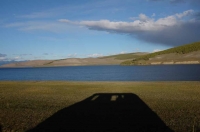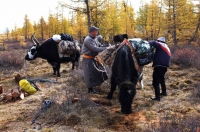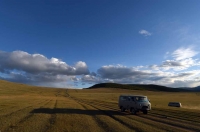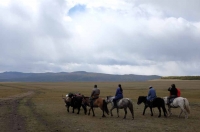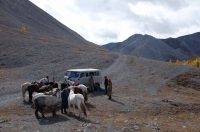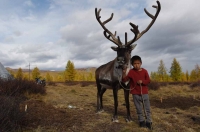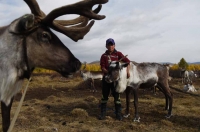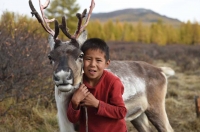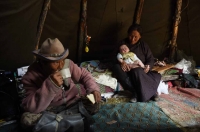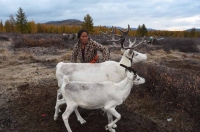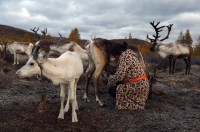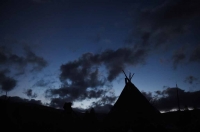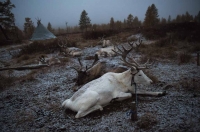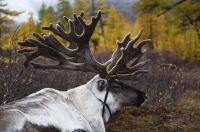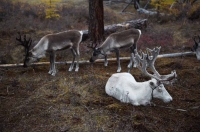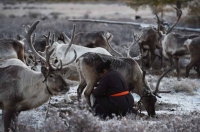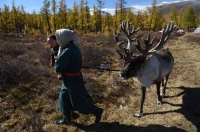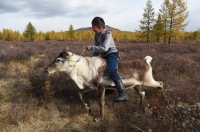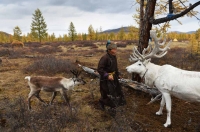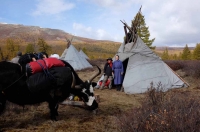Journey to a vanishing world
Tsagaan Nuur, Mongolia, December 23, 2015 -- I went to photograph reindeer herders in sub-zero temperatures in a remote corner of Mongolia as my holiday. Eight of the 12-day trip was spent travelling, much of it in the wilderness. It was an amazing journey.
My girlfriend and I are both photographers so when we had time off recently, we searched for somewhere to go in Mongolia that would be both visually interesting to shoot, and an adventure.
After some research we came across stories about reindeer herders in the remote north. The herders are among the last groups of nomadic reindeer herders left in Mongolia, and they face numerous challenges in maintaining traditions that go back thousands of years.
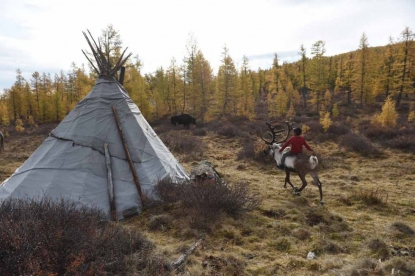 A boy rides on a reindeer past his ortz. (AFP / Greg Baker)
A boy rides on a reindeer past his ortz. (AFP / Greg Baker)They are from the Dukha ethnic minority - known in Mongolian as Tsaatan, which means "those who have reindeer" and depend on the animals for milk and for transport, but climate change is affecting their habitat and government restrictions aimed at conservation mean some of the areas they traditionally roamed are now off limits. A new ban on hunting wild animals has forced them to buy meat instead of hunting it, so they are no longer self-sufficient. And then there is the lure of modern living for the younger generation.
So the story looked interesting and the setting was beautiful. We decided to head there and see if we could photograph it. My girlfriend, Madoka, planned to shoot portraits and had brought her lighting equipment, while I planned to shoot more newsy stuff, when not acting as her lighting assistant.
But first we had to get there. The herders graze their animals in the taiga in the north of the country, the part that juts into Russia. The middle of nowhere would not be an inaccurate description.
What we didn’t know ahead of time was that getting there would be as amazing as the place itself.
When you head into such a remote place, preparation is everything. AFP’s stringer in Mongolia, Khaliun Bayartsogt, had set up the logistics. But we had to stock up for the trip -- four days of travel, much of it off-road, to get to the herders’ remote camp, then the time there and the journey back.
After we flew into the capital Ulan Batar we spent the rest of that day buying provisions.
You’re staying in tents most of the time, you take your sleeping bag, so you take simple stuff. Korean noodles and Korean packaged food that’s so popular in Ulan Bator these days, rice, pasta. We bought enough for ourselves and also to give to the people there, because we knew they had a need for it. In the end, we had a large carry case that took two of us to carry.
The first leg of the trip was a 13-hour bus ride to the city of Murun. From there, a driver picked us up in a Russian UAZ 4-wheel-drive. It was one of the coolest cars I’ve ever been in. It looks like a very dull, basic van, but it can go anywhere and is a real workhorse.
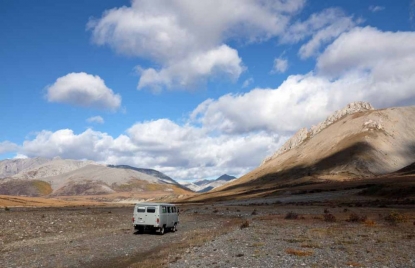 The UAZ wonder van on the journey from Khatgal to Tsagaan Nuur. (AFP / Greg Baker personal collection)
The UAZ wonder van on the journey from Khatgal to Tsagaan Nuur. (AFP / Greg Baker personal collection)Once you get to the area north of Murun, there are hardly any roads. We had a two-hour drive to Khatgal, on the shore of Khovskol lake. We got there at midnight and it was an offroad drive the whole way. The van had a sunroof and during the drive we saw a meteor fly over the top of us, at what looked like a very low level. It just flashed past. Anywhere else in the world it might have been news, but in remote Mongolia it probably went unnoticed by all but a few people.
We spent the night in a ger, a round Mongolian tent that is also known as a yurt. It was very well insulated, so it was very warm inside, despite it being around zero outside.
We spent the next day and night at the lake to have a rest and a look around at the spectacular scenery. Then the next day we were back in the van for a nine-hour offroad drive, which was incredible.
We were climbing through mountain passes at crazy angles, going over piles of rocks, and through river streams. At one point, we drove 15-20 kilometers in a dry river bed. It was actually the smoothest part of the trip. For one river crossing we needed to float the van across on a raft.
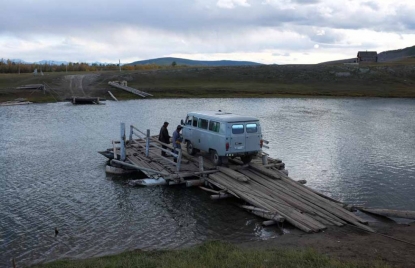 The UAZ wonder van is loaded onto a raft for a river crossing. (AFP / Greg Baker personal collection)
The UAZ wonder van is loaded onto a raft for a river crossing. (AFP / Greg Baker personal collection)Once again the Russian van had proved its worth. There are far more complex Japanese and Korean 4WD's available in Mongolia, but I think the drivers prefer the simplicity of the UAZ. They can be repaired more easily if they break down in remote areas. Eventually we got to Tsagaan Nuur, a small town, and spent the night in a small homestay. No showers, slept in sleeping bags, but at least we had a roof over our heads.
The next morning we had to get on horses for the last stage of the journey.
It was me, my girlfriend Madoka, Khaliun, the horse guide and our driver. The driver came because we actually needed two horse guides. We had a horse each, but we also needed animals to transport our bags and equipment, so the horse guide provided two oxen. It was a four and a half hour horse ride across the plains and into the forest where the Tsaatan people had set up their camp.
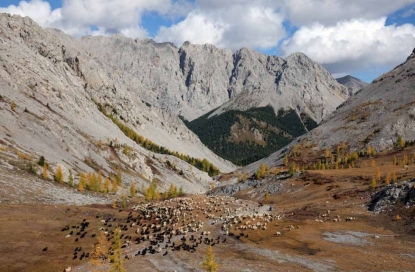 Herders move their sheep and goats through a mountain pass. (AFP / Greg Baker personal collection)
Herders move their sheep and goats through a mountain pass. (AFP / Greg Baker personal collection)The oxen provided some tricky moments. Our cameras were packed into the bags on their backs. And occasionally, they would run off to the side. So we had to watch as all of our gear dragged through the trees. Fortunately we had padded the cameras well and there was no damage.
When we got there, it was quite crowded. This place is known to tourists and there were probably about 12 to 15 foreigners already there, which is an unusually large number. The previous day, there had been three or four, but two other groups had arrived on the same day as we did. I was quite worried in terms of photography. It’s a very small camp, with only six or seven families and with that many visitors, it was going to be very hard to take photos that weren't full of foreigners.
The one stroke of luck that we had was that our first night there it got very cold. Plastic water bottles were frozen in the morning. So all those tourists left the next morning. They had such a rough night that they all left.
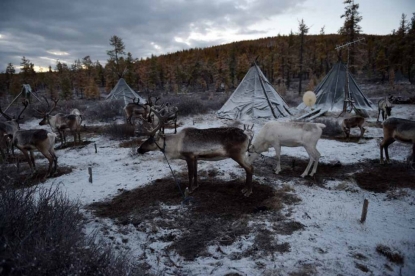 Reindeer at camp in the morning. (AFP / Greg Baker)
Reindeer at camp in the morning. (AFP / Greg Baker)The herders had set up a tent for us. It was called an ortz, a sort of a teepee. Unlike a yurt, it wasn’t insulated. We’d feel that in the mornings.
When we’d go to bed, with the stove still burning, it was toasty warm. But by about three o’clock the fire would burn out and it would get really freezing cold. But it’s nothing compared to what the herders themselves go through. We had maybe minus two or three degrees. In winter, it can get to be minus 40 or lower at night.
After we got there, I didn’t take pictures right away. I spent the first day getting to know the people. On that first day, we were going through Khaliun, who was translating for us. The driver and the horse guide knew the families, as they had taken people there before, so they helped a bit too. The next day, while out shooting, we communicated mostly by hand signals. It’s amazing just how much stuff you can get across with hand signals.
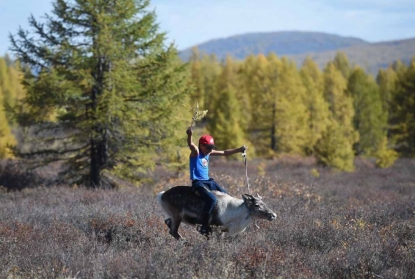 A boy and his reindeer. (AFP / Greg Baker)
A boy and his reindeer. (AFP / Greg Baker)The next morning, I got up and was looking around as the herders were preparing to take their animals out. One of them, as soon as he saw me with my cameras, started gesturing for me to follow him. His name, I later I found out, was Ganbat. He took about 20 of his reindeer out. The herders take them into the forest to forage for food, looking for a fresh place each day. We walked into the forest and he would make sounds, between a grunt and a woosh, to control their direction.
We went at dawn, around 8:00 am, and walked for about an hour. Ganbat tied their legs in a way that they can still walk around freely, but they can’t run. They’re so domesticated, that they generally stay together anyway. I took photos as they grazed. Then Ganbat went back to camp, leaving the reindeer to forage. He would go get the animals around noon.
Later that day, through hand signals, we arranged to meet the next morning to take the reindeer out.
In the morning, he took the reindeer out again and while they foraged he walked up into the hills, gesturing for us to follow. He started chopping down a small tree, a fir. He trimmed it carefully and as the sun rose over the hills he built a small fire and began tossing items he had brought with him into the air -- milk, biscuits and cigarettes. Khaliun wasn't with us at the time, so I didn’t know what was going on. I realized it was some kind of ceremony, but I didn’t know what exactly.
 Tsendeegiin Ganbat performs a ceremony honoring his late mother. (AFP / Greg Baker)
Tsendeegiin Ganbat performs a ceremony honoring his late mother. (AFP / Greg Baker)Later, when we got back to camp, I learned that he was performing a ceremony for his mother who died years earlier. I realized that he had invited me to come and watch him perform the ceremony with him. I felt honored that he would do that. It's one of my nicest memories from the trip.
Another is of Ganbat's wife milking their reindeer before dawn, followed by a beautiful, glowing sunrise over the camp. On our last day we saw Ganbat and his sons ride out of camp on their reindeer, as they headed to Tsagaan Nuur where the boys would spend the week at school.

Boys lead a reindeeer. (AFP/Greg Baker)
It was a long journey, but an amazing experience to be in such a beautiful, remote place, and to see the lives of a people struggling to maintain their traditions.
Greg Baker is an AFP photographer based in Beijing.
This blog was written with Yana Dlugy in Paris.

A Tsaatan woman with reindeer. (Photo courtesy of Madoka Ikegami)


